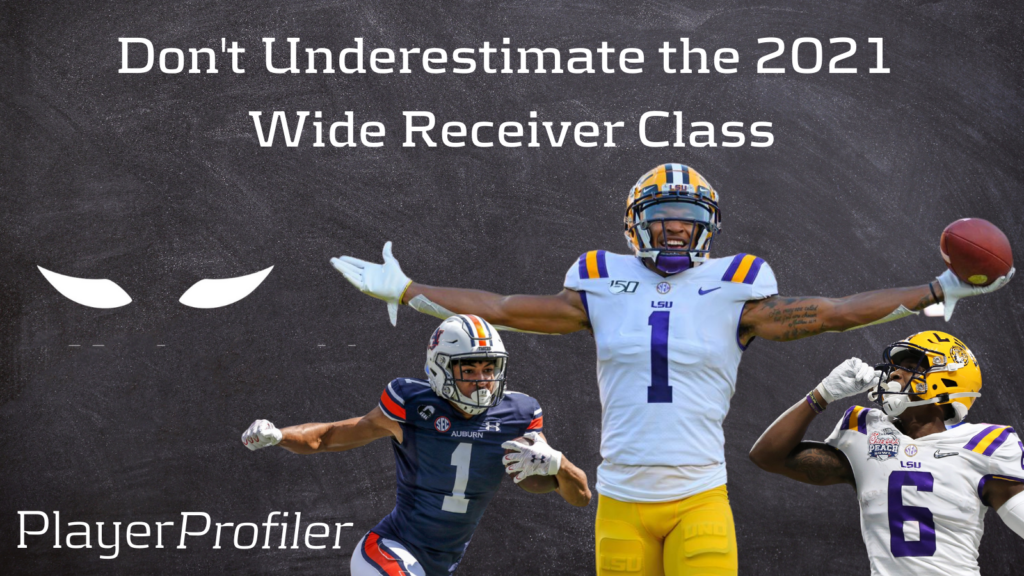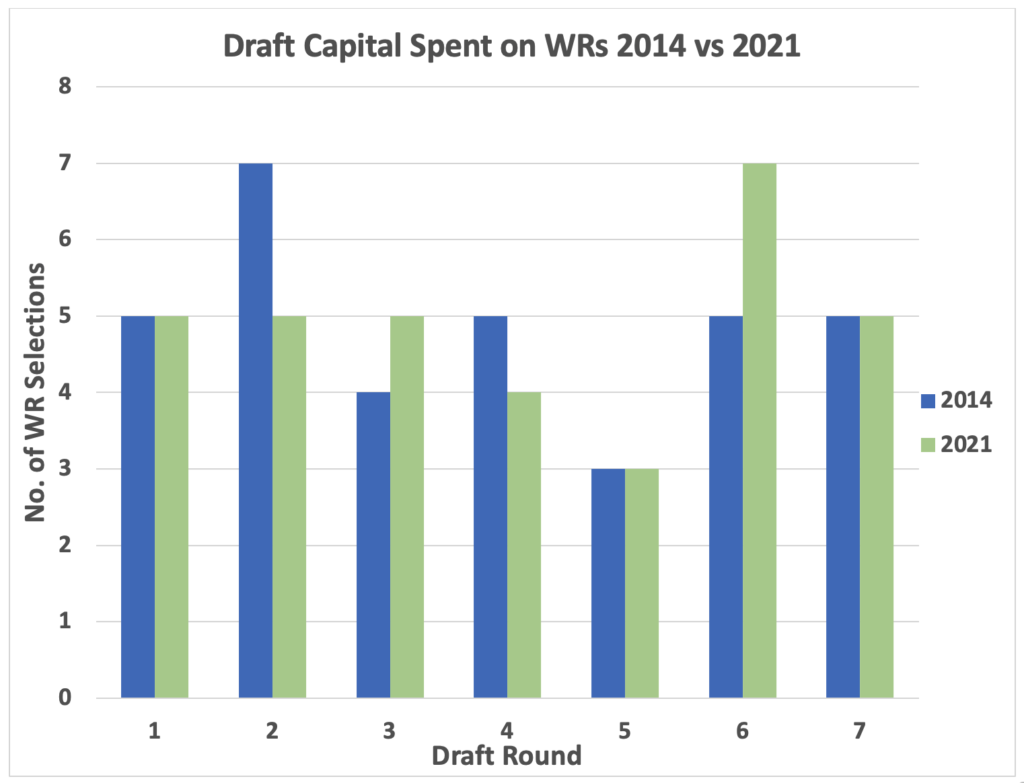
Last year around this time, I wrote an article comparing the 2020 wide receiver class with the vaunted group of 2014. The latter group includes multiple upper echelon fantasy football producers such as Mike Evans, Odell Beckham, Davante Adams, and Allen Robinson. The 2020 class did not disappoint, and in due time, may very well take the throne as the new gold standard. Using PlayerProfiler’s advanced stats and metrics, here’s the list of 2020 wideouts that check all the boxes in the comparisons of Draft Capital, Breakout Age, College Dominator Rating, and Speed Score. Impressive group.
Justin Jefferson, Tee Higgins, Laviska Shenault, Jalen Reagor, Denzel Mims, Gabriel Davis, Antonio Gandy-Golden, and Donovan Peoples-Jones
Note: Jerry Jeudy, and CeeDee Lamb narrowly missed the cutoff with Speed Scores in the high 90s.
Now that I have your attention, let’s take an analytical look to see how the 2021 WR class stacks up. Can the likes of Ja’Marr Chase, Devonta Smith, Rashod Bateman, and Elijah Moore join the elite?
Draft Capital
In a salary cap world, drafting well is critical to franchise success. As fantasy gamers, draft capital helps give us insight into how NFL front offices value incoming prospects. The 2014 and 2021 classes both saw a total of 34 wide receivers drafted, one less than 2020. This is on par with recent years (28 to 34 WRs selected each year since 2009), but let’s examine this round-by-round.

Draft capital spent on WRs 2014 vs. 2021
The chart above compares draft capital spent on wide receivers in 2014 and 2021. Other than Rounds 2 and 6, it’s quite similar. Two additional WRs were selected in Round 2 of 2014, however the first WR on Day 2 of 2021 (Elijah Moore) went five picks earlier. Both classes had 15 WRs chosen in the top 100 picks and Mr. Goodell called five wideouts to the podium in Round 1. NFL general managers continue the trend of investing valuable draft capital in the WR position, a resurgence seen in 2020 after a multi-year dip.
Verdict: The 2021 rookie wide receiver class is generally on par with the 2014 class in terms of the draft capital invested by NFL teams.
Breakout Age
We like to see that early Breakout Age associated with our WRs. The sooner a prospect is dominant on a college football field, the better their odds of NFL success. Of the 34 receivers selected in 2014, 14 of them (41-percent) had a Breakout Age of 20.0 or younger. The 2021 draft class once again holds its own with 15 WR prospects (or 44-percent) meeting the same standard. Six 2021 WR prospects draft on Day 3 had an early breakout, which exceeds the two receivers selected between Round 4 and 7 of 2014. The average breakout age for the two classes is practically identical.
Now we were spoiled last spring. The 2020 class had 18 prospects drafted (or 51-percent) meeting the same early Breakout Age threshold. However, this does indicate that the 2021 class has second highest number of early breakouts going back to 2014.
Verdict: The 2021 class has a slight edge on the 2014 class in terms of Breakout Age. Both trail the 2020 WR class.
College Dominator Rating
“First outlined by Frank DuPont in the book Game Plan, College Dominator Rating represents a player’s “market share” or his percentage of his team’s offensive production.” When comparing College Dominator Rating, the 2021 class takes a step back. The 2014 class holds an edge with 15 players posting greater than a 35.0-percent mark. In fact, the average for the 2014 class was an impressive 35-percent. The 2021 class trails with 12 WRs over 35-percent and an average Dominator Rating of 31.6-percent. Coincidently, this average is the same for the 2020 WR class.
While Michael Campanaro‘s 59.5-percent (98th-percentile among qualified wide receivers) College Dominator Rating may have helped boost the average, the 2014 class did have 10 wide receivers with a mark greater than 40.0-percent. Despite Mike Strachan contributing a rating of 54.7-percent (98th-percentile), the 2021 class has only six players surpassing 40.0-percent.
There is still good news, the 2021 class had 30 WRs exceeding a 20-percent Dominator Rating, only one less than 2014. The 2021 class may have several solid fantasy contributors, but less WR prospects with alpha potential.

College Dominator Rating breakdown – 2014 vs. 2020
For reference, a 35.0-percent or higher Dominator Rating indicates that a wide receiver has the potential to be a team’s No. 1 WR and/or a high caliber contributor. A 20.0 to 35.0-percent mark indicates a mid-level talent with situational upside. A mark under 20.0-percent is a red flag.
Verdict: Advantage goes to the 2014 class in terms of College Dominator Rating, but 2021 shows respectably.
Speed Score
Speed Score places a premium on 40-time, but also factors in body weight and length. And yes, the 2021 pro day 40-times have been corrected (for a refresher on why this is done, see here). The 2021 class struggles in this department with only 10 players (29-percent) hitting a Speed Score of 100.0 or higher. In comparison, 14 players (41-percent) met this cutoff for the 2014 group. This is not a surprise since many WRs weighed lighter and measured shorter than anticipated during the 2021 pro day circuit. Simi Fehoko‘s 113.7 (95th-percentile) Speed Score was top of the class.
Verdict: The 2014 group of wideouts has the edge in terms of Speed Score. The 2020 draft class had the highest number of receivers (17) with a Speed Score of 100-plus in over 10 years.
Conclusion
The 2014 and 2021 wide receiver draft classes share similarities. The draft capital spent by NFL teams and Breakout Ages for these two groups are on par. Both classes have impressive College Dominator Ratings, with the 2014 class holding an edge. A lackluster showing in the Speed Score comparison holds the 2021 class back in that area. However, the 2021 group is no slouch by any means. Albeit shorter, the 2021 class still produces a solid list of WRs that check multiple analytical boxes: a Breakout Age of 20.0 or less, College Dominator of at least 25.0-percent, and a Speed Score over 100.0. Here are the 2020 receivers that meet this criteria:
Ja’Marr Chase, Terrace Marshall, Nico Collins, Anthony Schwartz, Seth Williams, and Kawaan Baker
Note: Rashod Bateman, Rondale Moore, and Dyami Brown check two of three boxes, but missed the Speed Score cutoff scoring in the 90s. DeVonta Smith did not test.
For reference, the 2014 group looks like this:
Sammy Watkins, Mike Evans, Odell Beckham, Brandin Cooks, Jordan Matthews, Cody Latimer, Allen Robinson, and Donte Moncrief.
No doubt that we were spoiled by the 2020 WR class, which fared well in this same comparison and posted some quality success rates by route last season. While still ascending, it looks like fantasy gold. Perhaps this raised expectations for the 2021 class. Regardless, don’t let that cloud your outlook on the current crop of WRs. Listen to the data since it outlines several promising rookie WRs that will be catching passes and scoring touchdowns soon.
By now, many of the rookie WRs are safely stashed on dynasty rosters and taxi squads. Double check the waiver wire for some hidden gems. In redraft leagues, don’t hesitate take advantage of those skeptical of immediate rookie production and scoop up them up in the later rounds.
The 2021 wide receiver class hold its own with the vaunted 2014 class, and that’s worth investing in.




